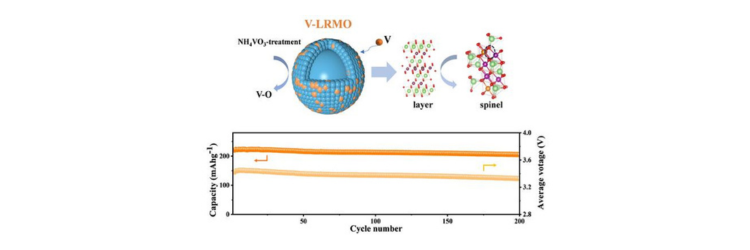
The global push for electric vehicles (EVs) and renewable energy systems demands advancements in lithium-ion battery technology. While materials like LiFePO4 and Li-Ni-Co-Mn-O are industry standards, they often fail to balance high energy density with cost-effectiveness. Lithium-rich manganese oxides (LRMOs) have emerged as a promising alternative, offering high capacity without cobalt. However, challenges such as low initial Coulombic efficiency (ICE) and rapid voltage decay have hindered their widespread use.
A recent study by Guangdong University of Technology researchers, led by Dong Luo and Chenyu Liu, offers a breakthrough in stabilizing LRMOs for practical applications. Published in Energy Materials and Devices (DOI: 10.26599/EMD.2024.9370039), the study demonstrates a simple hydrothermal treatment that significantly enhances the performance of LRMO cathodes.
The team treated lithium-rich cathode materials with NH4VO3, introducing vanadium to the material’s surface and forming a V-doped spinel-layered structure. This modification achieved remarkable results:
- Improved Initial Coulombic Efficiency (ICE): The ICE jumped from 74.4% to 91.6%, exceeding the threshold for commercialization.
- Enhanced Voltage Stability: The cathode exhibited minimal voltage decay, only 0.47 mV per cycle over 200 cycles.
- Structural Stability: Vanadium’s strong V-O bonds reduced irreversible oxygen release, stabilizing the redox process and improving lithium-ion diffusion.
The lead scientist, Professor Dong Luo, commented, “Our findings offer a practical and highly effective method for tackling the persistent challenges of low Coulombic efficiency and voltage decay in lithium-rich cathodes. By incorporating vanadium, we’ve significantly improved redox stability and voltage performance, paving the way for next-generation lithium-ion batteries to meet the growing energy needs of sectors like electric vehicles and renewable energy storage.”
The enhanced LRMO cathodes have far-reaching implications for EVs, renewable energy systems, and consumer electronics, where efficiency and longevity are critical. The technology promises cost savings and a more sustainable energy future by eliminating cobalt and improving stability. As this approach scales, it could accelerate the global transition to cleaner power sources.
